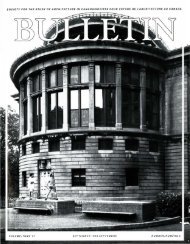CANADA - SEXTONdigital
CANADA - SEXTONdigital
CANADA - SEXTONdigital
You also want an ePaper? Increase the reach of your titles
YUMPU automatically turns print PDFs into web optimized ePapers that Google loves.
P IERRE DE LA RUFFINitRE Du PREY > POSTSCRIPT I POSTFACE<br />
FIG . 2. ~TAPLES MILITARY CEMETERY. FRANCE: EDWIN<br />
LUTYENS. CLOSE-UP OF ONE OF THE PYLONS. I P1ERR£<br />
DUPREY 1987.<br />
hospital and base camp. Seen from the<br />
train line below, or from the main road<br />
among the trees up above, a carpet of<br />
around 10,000 gravestones, including<br />
2010 Canadian ones, creates an awesome<br />
sight (fig. 1). Religious symbolism<br />
was deliberately restricted to the minimum.<br />
The centrally positioned Cross of<br />
Sacrifice, a standard feature designed by<br />
Blomfield, is flanked at either end of the<br />
platform by twin Lutyens pylons, anticipating<br />
those of Allward at Vimy. Gavin<br />
Stamp's article earlier in this issue calls<br />
these pylons "cenotaphs", thus drawing<br />
attention to their similarity to Lutyens's<br />
Cenotaph on Whitehall in London<br />
(cf_ Stamp figs. 2, 13).<br />
Lutyens conceived of the end pylons at<br />
Etaples as sentinels, or "silent witnesses<br />
to the desolation of war", to quote the<br />
memorable phrase of King George V during<br />
his 1922 pilgrimage to some of the<br />
cemeteries (including Eta pies). 2 Here, on<br />
this artificial plateau, Lutyens resurrected<br />
the idea of ornamenting the pylons with<br />
drooping flags- an idea he was forced to<br />
reject at the Cenotaph. He placed them so<br />
they point skyward, drawing attention to<br />
the topmost element, which is in reality a<br />
stylized, flag-draped coffin like a Roman<br />
sarcophagus. Specifically Christian references<br />
fade away, and Lutyens invokes the<br />
classical tradition to impart a feeling of<br />
the eternal and never-changing aspects<br />
of that tradition, as he understood it.<br />
Further to intensify the hush, the carved<br />
flags do not flutter bravely but rest limp<br />
and motionless.<br />
Focusing in on one of the pylons (fig. 2),<br />
a laurel wreath can be seen lying on top<br />
of the sarcophagus. On the long sides<br />
a garland of foliage held up by ribbons<br />
replaces the laurel wreath motif_ The<br />
garland has a classical French eighteenth-century<br />
look to it- appropriate to<br />
Etaples's location - although the leaves<br />
are obviously oak, symbolic of England.<br />
They strike the only real note of naturalism<br />
in the fundamentally geometric play<br />
of simple shapes. Even the flags, according<br />
to David Watkin "hang frozen and<br />
deathly in the air". 3 Lutyens abstracted<br />
their form so as to avoid the impression<br />
of anything transitory and flimsy. No<br />
doubt Lutyens's eye would have appreciated<br />
the astonishing shadow cast on<br />
the stonework by the metal crown at the<br />
top of one of the flag poles.<br />
Gavin Stamp and Jacqueline Hucker point<br />
out in their separate articles that one of<br />
the hardest - indeed grimmest- tasks<br />
during and immediately after World War<br />
I was deciding how best to commemorate<br />
those lost in action . There were<br />
hundreds of thousands of names with<br />
no remains. Memorials to the so-called<br />
Missing were erected at or near to the<br />
battlefields where they were believed to<br />
have fallen, or ports from which they had<br />
sailed. Fabian Ware, the Vice-Chairman<br />
of the Imperial War Graves Commission,<br />
hoped the Dominion Governments would<br />
join forces with the Commission, use its<br />
architects, and follow its guidelines. But<br />
the Memorial to the Missing Australians,<br />
on the battlefield where they had<br />
distinguished themselves at Villers<br />
Bretonneux, is an interesting instance<br />
of what actually happened. A design<br />
competition took place in 1925 and the<br />
little-known Australian architect William<br />
Lucas won it, although Lutyens eventually<br />
supplanted him. The last of the Memorials<br />
completed, two years later than Vimy, it<br />
shows how Lutyens skilfully adapted the<br />
previous design. Notably, he retained Lu <br />
cas's idea of a central columnar lookout<br />
tower to honor the 10,866 Missing.• But<br />
Lutyens reduced the importance of classical<br />
columns by relegating them to elegant<br />
door frames, while still maintaining<br />
overall classical symmetry (fig. 3). The<br />
out-lying pavilions have pyramidal roofs,<br />
an oblique reference perhaps to the Egyptian<br />
cult of the dead, at the same time as<br />
the tetrahedron shape keeps pace with<br />
the severely elemental geometry that<br />
Lutyens preferred in his late work. Each<br />
corner has rain-soaked-looking flags executed<br />
in a more stripped-down fashion<br />
than at Etaples.<br />
These "sad flags", so to speak, recur at<br />
the corners on the upper stage of the<br />
tower (fig. 4). (Notice how, in the closeup,<br />
bullets fired by World War II German<br />
aircraft in June 1940 scarred the surface<br />
of the World War I monument less than<br />
four years after its inauguration.)S<br />
Lutyens's largest monument to the Missing,<br />
the moving Thiepval Memorial, rises<br />
145 feet above the peaceful landscape<br />
where the Battle of the Somme once<br />
raged on one of the most blood-soaked<br />
stretches of earth in human warfare. The<br />
commemoration of so many in a single<br />
structure at Thiepval came about because<br />
58<br />
JSSAC I JStAC 33 > N• 1 > 2008
















